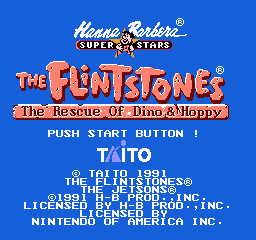The Flintstones: The Rescue of Dino and Hoppy
| The Flintstones: The Rescue of Dino and Hoppy |
|---|
|
Developer: Sol
|
The Flintstones: The Rescue of Dino and Hoppy is an NES game featuring everyone's favorite modern stone-age family in a time travel journey to rescue their kidnapped pets.
Contents
Debug Mode
US/Europe
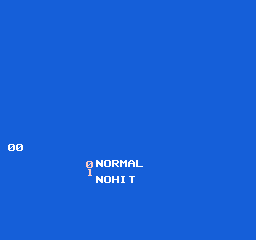
The game stores a sequence of button presses in memory at the title screen but jumps right over the code that checks them. To reactivate the routine, enter Game Genie code SKKALTIZ VEKAGTNA (SKKELVIX VEKEGTNA in the European version).
After the codes are entered, wait for the "PUSH START BUTTON!" text to appear, then press Up, Right, Right, Right, Down, Down, Down, Down, Left, Left, Start. If you mess up while entering the code, press B to start over.
Alternatively, to jump straight to the debug menu, use Game Genie codes KKKALTIX VEKAGTNA (KSKELVIZ VEKEGTNA in the European version).
You'll then be presented with two options, NORMAL or NOHIT. NORMAL is the standard gameplay, while NOHIT enables some interesting features:
- Fred will pass through enemies unharmed, and will start with all three special abilities (FLY, JUMP, and DIVE).
- FLY and DIVE can be used for free, provided you have enough coins to cover the usual cost.
- Pressing B on Controller 2 will freeze or unfreeze the game. While frozen, tapping A will advance the game frame-by-frame (or you can hold the button for slow-motion).
- Press Up on Controller 2 to end the current level and mark it as "passed" on the map screen.
After selecting one of the two options, a number will appear, which acts as both a sound test and level selection. Press Up or Down to change the number, A to play the selected music or sound effect, B to stop it, or Start to start the game at the selected scene.
Japan
Debug Mode
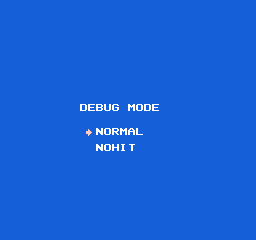
The Japanese version has the cheat sequence enabled, though the code itself is different. Wait for the "PUSH START BUTTON!" text to appear, then press A, A, B, B, Right, Down, Down, Down, Down, Down, Down, Down, Left, Start. Everything else works the same as the US and European versions.
Test Mode

In addition to the debug mode, the Japanese version has a "Test Mode" which skips the "NORMAL/NOHIT" portion and just goes to the level select/sound test. To access it, wait for the "PUSH START BUTTON!" text to appear then press A, B, A, B, Up, Right, Right, Right, Down, Down, Down, Down, Left, Left, Start.
Unused Enemy
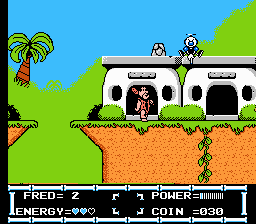
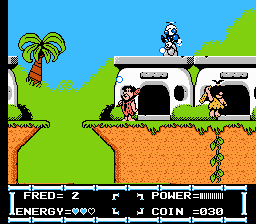
A variation of the enemies in the final stage that bounce around on springs. The difference is that this one hovers in the air in a swooping motion and fires a gun in three possible directions. It's fully coded and perfectly functional.
Unused Graphics
| To do: Get better rips of some of these. |
A number of unused sprites are present in the ROM, though none of them seem to be associated with any actual code anymore. A large number of these were removed from the Japanese release, including the dragon, fan blades and bolts, tilted logs, and the snail shell.
| Artwork | Description |
|---|---|
| Apparently, the little Fred at the top of the title screen was supposed to be animated. No code has been found to display the extra frames, though. | |
| A dialogue sprite for Fred. Since he has no dialogue in this game, this goes unused. A different version of the first frame with an outline is used during the bonus games, however. | |
| A boomerang weapon pickup. Oddly enough, this is stored below the time machine part ("TM") sprite, and is not in the 8×16 format used by the rest of the game's sprites. | |
| The small blobs fired by the blue snail enemies are supposed to have two frames of animation, but only the left half of the first frame is used. | |
| Propeller blades and bolts that were clearly intended for the final stage, which takes place in the future. | |
| Either a pincer claw or a platform, also intended for the final stage. | |
| A dragon enemy. | |
| It seems the toothy fish enemy from the underwater stage could somehow lose its teeth, the first two frames are used by the game and are provided here for reference. | |
| A waving flag or banner (or possibly a carpet) and an exploding molotov cocktail. Neither Fred nor any enemy has such a weapon. | |
| A weird goblin head that would apparently pop out of a hole and spit something at the player. | |
| A martial artist character and a giant fireball stored with the other graphics for the Asian village stage. | |
| The log platforms carried by the pterodactyls were supposed to tilt, but they remain completely horizontal in the final game. | |
| Appears to be an early version of the saber-toothed cat enemy, the one in the final game looks completely different from this one. | |
| Although this shark would have easily fit in with the underwater stage, it is nowhere to be found. | |
| A giant snail shell that would roll. Fred occasionally rides an object through part of a stage, possibly what this was intended for. | |
| A fire-breathing stegosaurus-like enemy. | |
| Not technically unused, but hidden: in the final stage, changing the background color reveals some previously unseen details in the tall structures, which may indicate that the background was not originally supposed to be black. Of note is that the background used in the future section during the time travel cutscene is dark purple as opposed to black. |
Regional Differences
| International | Japan | Translation |
|---|---|---|
PROGRAMMER MISAKO KAWAMURA K-ICHI SAITO GRAPHIC DESIGNER T. KODAMA M. SAITO T. KAWAISHI I. MATONO NISIYAMAN PLANNER NISHIYAMAN I.MATONO SOUND COMPOSER Y. YAMADA N. YAGISHITA COORDINATOR H. KAJITA H. HIRAIWA SPECIAL THANKS TO T. HORIMOTO K. BANDO Y. KANNO K. ITO Y. KOGA ONIJUST Y. NAKANISHI S. YASUDA L. STALMAH T. KATO Y. SUZUKI S. NAKATA N. KUROKI N. NAKAIZAWA PRESENTED BY TAITO |
ぷろぐらま〜 みさこ かわすら け〜いち さいと〜 ぐらふぃっく でざいな〜 としひこ こだま しん さいと〜 と〜る か〜いし じょ〜じ まとの まいける にしやま ぷらんな〜 (Planner) まいける にしやま じょ〜じ まとの さうんど (Sound) やすこ やまだ なおと やぎした こ〜でぃね〜た〜 ひでき かじた ひろ ひらいわ ぷれぜんてっど ばい TAITO |
Programmer Misako Kawamura Keiichi Saito Graphic Designer Toshihiko Kodama Shin Saitoh Tohru Kaishi George Matono Michael Nishiyama Planner Michael Nishiyama George Matono Sound Yasuko Yamada Naoto Yagishita Coordinator Hideki Kajita Hiro Hiraiwa Presented by TAITO |
The staff roll has some differences between versions:
- The Japanese version is completely in hiragana, even when some of the text should be in katakana.
- Toshihiko Kodama in the Japanese version was changed to T. Kodama.
- Shin Saitoh in the Japanese version was changed to M. Saito.
- Tohru Kaaishi in the Japanese version was changed to T. Kawaishi.
- George Matono in the Japanese version was changed to I. Matono.
- Michael Nishiyama in the Japanese version was changed to Nisiyaman/Nishiyaman.
- Yasuko Yamada and Naoto Yagishita in the Japanese version were changed to Y. Yamada and N. Yagishita respectively. The same goes for the people in the coordinator credits, Hideki Kajita and Hiro Hiraiwa.
- The international versions have a Special Thanks To list, consisting of 14 people.
The Flintstones series
| |
|---|---|
| Arcade | Fred Flintstone's Memory Match |
| NES | The Rescue of Dino and Hoppy • The Surprise at Dinosaur Peak! |
| SNES | The Treasure of Sierra Madrock • The Flintstones (Prototype) |
| Game Boy (Color) | King Rock Treasure Island • The Flintstones • Burgertime in Bedrock |
| Sega Master System | The Flintstones |
| Genesis | The Flintstones (Taito) |
| Game Boy Advance | Big Trouble in Bedrock |
| Windows | Bedrock Bowling |
| PlayStation | Bedrock Bowling |
| PlayStation 2 | Bedrock Racing |
| Adobe Shockwave | Fred Rocks |
- Pages missing developer references
- Games developed by Sol
- Pages missing publisher references
- Games published by Taito
- NES games
- Pages missing date references
- Games released in 1991
- Games released in December
- Games with unused enemies
- Games with unused graphics
- Games with debugging functions
- Games with hidden sound tests
- Games with hidden level selects
- Games with regional differences
- Pages with a Data Crystal link
- To do
- Flintstones series
Cleanup > Pages missing date references
Cleanup > Pages missing developer references
Cleanup > Pages missing publisher references
Cleanup > To do
Games > Games by content > Games with debugging functions
Games > Games by content > Games with hidden level selects
Games > Games by content > Games with hidden sound tests
Games > Games by content > Games with regional differences
Games > Games by content > Games with unused enemies
Games > Games by content > Games with unused graphics
Games > Games by content > Pages with a Data Crystal link
Games > Games by developer > Games developed by Sol
Games > Games by platform
Games > Games by publisher
Games > Games by publisher > Games published by Square Enix > Games published by Taito
Games > Games by release date > Games released in 1991
Games > Games by release date > Games released in December
Games > Games by series > Flintstones series
The Cutting Room Floor > Unimportant Awards > NES games
